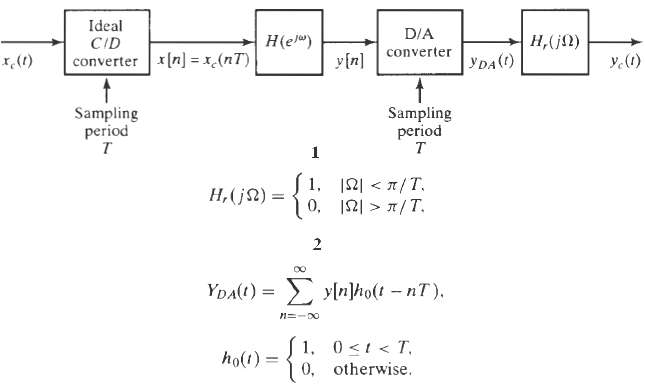Consider the system in Figure. 1. Assume that X c (j?) = 0 for |?| ? ?
Question:
Consider the system in Figure.
1. Assume that Xc(j?) = 0 for |?| ? ? / T and that denotes an ideal lowpass reconstruction filter.
2. The D/A converter has a built-in zero-order-hold circuit, so that where (we neglect quantization in the D/A converter.)?
3. The second system in Figure is a linear-phase FIR discrete-time system with frequency response H(ej?). We wish to design the FIR system using the parks-McClellan algorithm to compensate for the effects of the zero-order-hold system.
(a) The Fourier transform of the output is Yc(j?) = Heff(j?) Xc(j?). Determine an expression for Heff(j?) in terms of H(ej?T) and T.
(b) If the linear-phase FIR system is such that h[n] = 0 for n 51, and T = 10?4s, what is the overall time delay (in ms) between xc(t) and yc(t)?
(c) Suppose that when T = 10?4 s we want the effective frequency response to be equiripple (in both the passband and the stop band) within the following tolerances:?
0.99 ? |Heff(j?)| ? 1.01,? ? ? ? ? ? |?| ? 2? (1000),
|Heff(j?)| ? 0.01,? ? ? ? ?? 2?(2000) ? |?| ? 2?(5000).?
We want to achieve this by designing an optimum linear-phase filter (using the parks McClellan algorithm) that includes compensation for the zero-order hold. Give an equation for the ideal response Hd(ej?) that should be used. Find and sketch the weighting function W(?) that should be used. Sketch a ?typical? frequency response H(ej?) that might result.
(d) How would you modify your results in part (c) to include magnitude compensation for a reconstruction filter Hr(j?) with zero gain above ? = 2?(5000), but with sloping passband??

Step by Step Answer:

Discrete Time Signal Processing
ISBN: 978-0137549207
2nd Edition
Authors: Alan V. Oppenheim, Rolan W. Schafer





